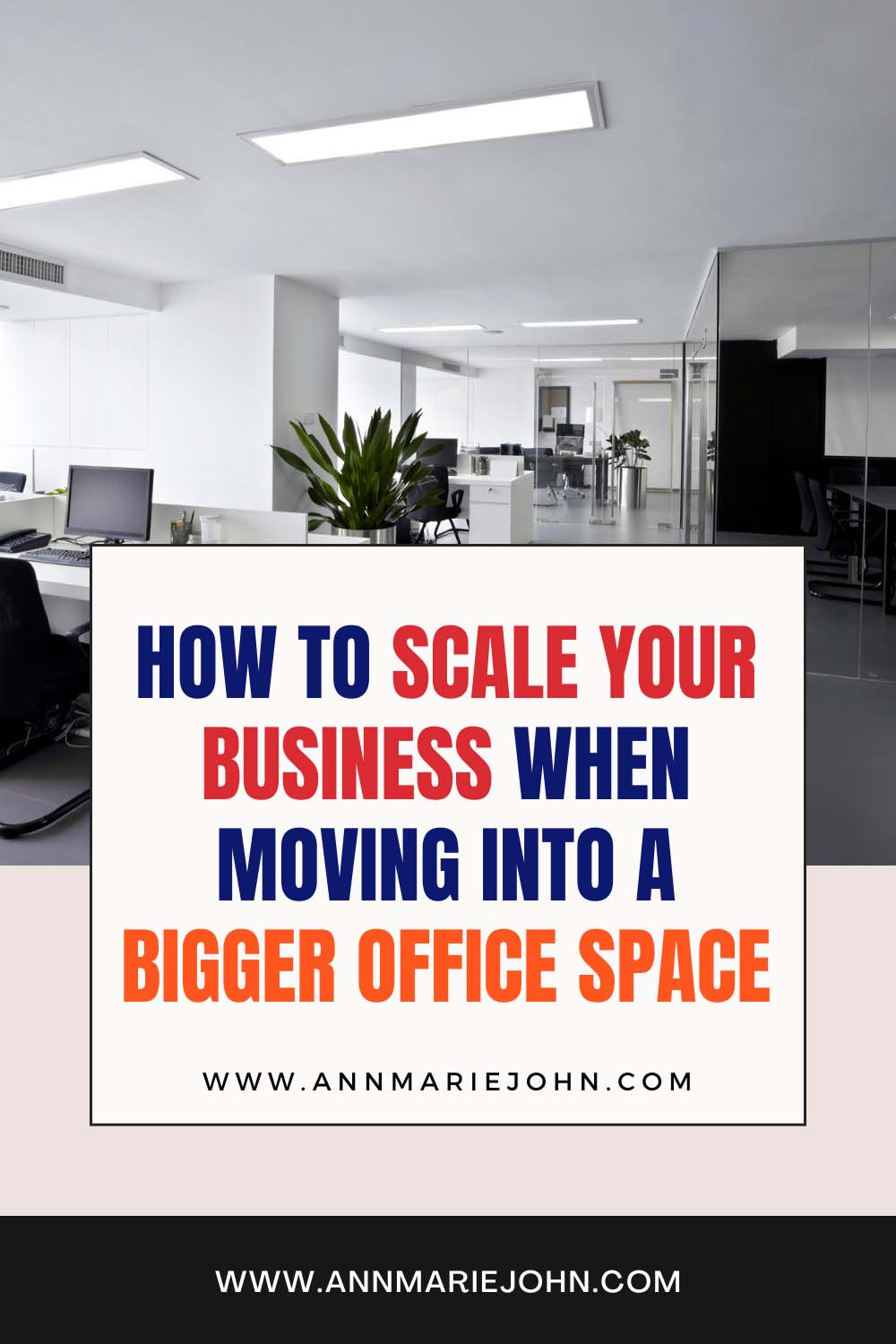Navigate the transition to a larger office space seamlessly. Discover strategies to scale your business effectively and optimize your new workspace.

Expanding your business is an exciting endeavor, and one of the most obvious signs of growth is the need for more office space. But moving to a larger office can be a daunting task, and the last thing you want is for your company to lose momentum during this transition. In this post, we’ll explore strategic steps to ensure a seamless scaling process so your business can thrive in your newly expanded environment.

1. Strategic Planning for Growth
Careful planning is important before making a physical move. First, assess your current business needs and anticipate future needs. To do this, you need to understand your current team size, the equipment you need, and the infrastructure you need to operate optimally. Take a thorough look at your existing office resources to determine what can be reused and what needs to be replaced. Knowing your growth trajectory will help you determine the size and layout of your new office space.
2. Financial Considerations
Upsizing comes at a cost, so it’s important to have a clear financial plan. Calculate the estimated costs associated with the move, including lease costs, renovation costs, and potential downtime. Create a budget that accounts for these costs while also accounting for unexpected expenses. Also, look into financing options such as loans and grants to ensure you have cash flow to get through the transition period.
3. Identifying and Retaining Talent
Relocating to larger office space may require hiring additional employees. Identify the key roles you will need to support your growing business. At the same time, emphasize retention of existing talent by communicating the benefits of relocation, such as improved working conditions and advancement opportunities. A smooth transition is about more than just physical logistics. It is also important to maintain a motivated and cohesive team. Consider implementing employee retention programs and incentives to ensure key team members remain engaged during the transition.
4. Efficient Interior Design
The design of your new office space plays an important role in productivity and collaboration. Work with an interior designer to create an efficient layout that meets your business needs. Consider space requirements for different teams, conference rooms, and common areas. When designing, consider flexibility and scalability to accommodate future growth. An ergonomic and comfortable environment contributes to employee satisfaction and, ultimately, business success.
5. Technology Infrastructure
To scale seamlessly, your business needs a robust and scalable technology infrastructure. Assess your current IT setup and identify gaps that need to be addressed. Work with IT experts to ensure a smooth transition of your digital assets, including data migration, network configuration, and the installation of necessary equipment. Consider adopting a cloud-based solution for greater flexibility and accessibility. A well-integrated technology infrastructure is the backbone of any growing company.
6. Effective Communication
Open and transparent communication is key to a transition of this scale. Inform your team ahead of time about this transition and explain the reasons for it and the benefits it will bring. Be ready to address their concerns and provide a timeline for the migration. Additionally, communicate with customers and stakeholders to minimize disruptions to operations. Maintain clear and open communication throughout the process to foster trust and understanding.
7. System Testing and Optimization
Perform thorough testing of all systems, including IT infrastructure, communication channels, and security protocols, prior to the actual move. This helps identify potential problems before they impact day-to-day operations. Optimize workflows and processes as needed and take advantage of opportunities to implement improvements that align with company growth goals. This may include running simulation scenarios to ensure all systems operate smoothly in the new environment.
8. Employee Training and Onboarding
Larger office space allows for new tools, technology, and processes. Provide comprehensive training to your employees to ensure a smooth transition. This includes making sure they understand the new office layout, technology systems, and updated policies. Plan your training well before your move to minimize disruption. Investing in training will result in increased efficiency and a faster return to normal operations.
9. Maintaining Customer Service Levels
It is important to maintain a high level of customer service during the relocation period. Clearly communicate potential disruptions to customers and implement strategies to minimize the impact. Consider temporarily hiring additional customer support staff to handle inquiries and ensure customers feel supported and valued during the transition. Having a customer communication plan in place will help you manage expectations and demonstrate your commitment to excellent service.
10. Customer and Supplier Transition Support
Communicate with customers and suppliers throughout the transition period to ensure a smooth handover. Provide current contact information, address any changes in procedures or billing, and reassure them that you are committed to maintaining service levels. This proactive approach minimizes the impact on business relationships and increases trust. Consider hosting a customer or supplier appreciation event in your new space to strengthen ties and introduce your new facility.

11. Security and Privacy
If you’re moving to a larger office, it’s paramount that you reconsider and improve your security measures. Work closely with security experts to install and optimize access control systems, surveillance cameras, and cybersecurity protocols. It’s important to protect sensitive data during migration. Ensure that employees are aware of current security procedures and that all necessary precautions are taken to protect both physical and digital assets.
12. Community Integration and Networking
Moving to a new location provides an opportunity to integrate your business into the local community. Attend local networking events, join business associations, and network with businesses in your area. Building a strong presence in the community not only strengthens your brand but also opens up possibilities for partnerships and collaborations. Collaborating with local communities can be especially beneficial if your business relies on local customers or partnerships.
13. Sustainable Practices
Consider incorporating sustainable practices into your new office space. From energy-efficient lighting, HVAC software, and smart appliances to waste reduction programs, adopting environmentally friendly practices is not only consistent with corporate responsibility, but it can also save you money in the long run. Involving employees in sustainable practices and communicating your commitment to environmental responsibility can have a positive impact on your brand image.
14. Flexibility of Operations
The more office space you have, the more flexibility you should have in how you run your business. Take advantage of flexible work arrangements, including remote work options and flexible work hours. Create dynamic workspaces that suit different work styles and preferences. Flexibility fosters a positive work environment and can attract and retain top talent. Additionally, it allows your business to adapt to changing market conditions and evolving industry trends.
15. Continuous Improvement and Adaptation
Moving to more office space isn’t the end of the story. This will serve as a stepping stone to further growth. Promote a culture of continuous improvement within your company. Regularly evaluate and review processes, strategies, and goals. Encourage innovation and proactively adapt to new technologies and industry best practices. The ability to evolve and embrace change is essential to long-term success in a dynamic business environment.
16. Improving Employee Well-being and Morale
Moving to a larger office space can cause stress and confusion for employees. Implement strategies that prioritize their well-being during this transition period. Consider offering wellness programs, organizing team-building activities, and providing support services. A positive and supportive work environment contributes to improved morale and productivity, allowing you to keep your team engaged and motivated while on the road.
17. Brand Awareness and Signage
Maximize brand awareness in your new location by strategically placing signage both inside and outside your office. This is a great opportunity to refresh the look of your brand and leave an unforgettable impression on your customers, visitors, and even passersby. Invest in professional, eye-catching signage that reflects your company’s values and conveys a strong brand identity. A properly branded office space contributes to a professional and consistent image.
18. Legal and Regulatory Compliance
When you move to a new location, your business may be subject to different legal and regulatory requirements. Be aware of and comply with all local laws, permits, and zoning regulations. Consult a legal professional to clarify your legal obligations related to the move. Compliance is important not only to avoid legal issues but also to build good relationships with local communities and authorities.
19. Disaster Preparedness and Business Continuity
As you expand your business, it’s important to plan for the unexpected. Develop a solid disaster preparedness and business continuity plan that describes what to do in the event of an emergency such as a natural disaster, power outage, or other unexpected event. This plan should include data backup and recovery, temporary work arrangements, and communication protocols. Being prepared will help your business recover quickly and get back to work in the event of an interruption.
20. Post-Move Evaluation and Adjustment
After the move, perform a thorough evaluation of the entire process. Identify what went well and what needs adjustment. Gather feedback from employees, customers, and stakeholders to gain insight into their experience during the transition. Use this information to adjust your scaling strategy for future growth. Consider holding a debriefing session with your team to discuss lessons learned and implement appropriate changes. Post-move evaluations are a valuable step toward continuous improvement.
In Conclusion
Expanding your business and moving into a larger office space is an important milestone. Careful planning, strategy execution, and a focus on communication will ensure that the transition is smooth and your business continues to grow in the new environment. By considering the logistical, financial, and human aspects of migration, you can create the conditions for sustainable growth and success. Remember, the key to scaling without delay is proactive planning and a commitment to team well-being and customer satisfaction.
